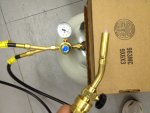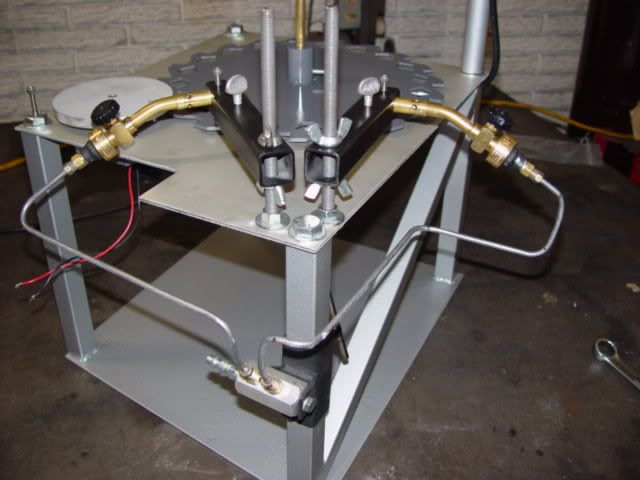As you know, I offer a brass service where I do case cleaning and annealing. (PM me if interested)
I've used a Bench-Source annealing machine for a a number of years and have annealed more than 40,000 cases with it.
I didn't take long to find a shortcoming in the the small LPtanks. As they deplete with use, the pressure to the torchhead will vary, requiring adjustments to the torch. Not the best situation when we're looking for absolute consistency from case to case!
I found another Bench-Source user who had rigged his unit to run both torchheads from one refillable propane tank.
I've shared this with a few via PM and thought it would be worth sharing with everyone who is interested.
The list and process should be easily understood but if anyone needs help, just send a PM.
This is what we're aiming for:

This is what you need to buy:
From Flame Engineering (http://www.flameengineering.com/Cylinder_Connectors.html):
P-W 795
Hand-tighten Excess Flow P.O.L. Fitting
1/4" MPT OUTLET (need 1)
F-140
Cylinder Adaptor
1/4" FPT x 1" 20 Male Thread (need 2)
I bought the below items from Amazon.com only because I couldn't find them locally. You might have better stocked hardware stores or possibly a HomeDepot/Lowes/Menards.
1/4" MPT x 1/4" barbed fitting (male fitting, need 6)
1/4" FPT "T" (female fitting, need 1)
1/4" FPT coupling (female fitting, need 1)
From most any welding supply store purchase:
1/4" 350 PSI gas hose (need 10 feet)
1/4" brass ferrules (need 6)
Cut two 12" lengths from the hose. Push ferrules onto each hose-end then push in the barbed fittings and crimp the ferrules. These 12" pieces go from the torchheads to the T connector. The 8' piece of hose goes from the T to the tank. (ferrules can be bought at a welding store - I had the guy there use their ferrule-tool to crimp them right there)
The photo shows the T connector mounted to the side of the machine. I didn't do this, I didn't want to open it up to reach the backside of the fasteners. Another way would be to braise the connector to a plate and use metal screws to connect the plate to the side. Leaving it loose does not hurt a thing. When not in use, I coil the hose on top of the unit. The LP tank stays outside when not being used. I usually anneal in the garage/shop unless it's freezing, then it goes in the kitchen.
I use a BBQ lighter to ignite the torchheads. The pressure to each torch is very equal using this conversion. This was often a problem using the little tanks, especially as they were depleted, they often required close monitoring to ensure consistency over a long run.
Good luck and good shooting,
Bob
I've used a Bench-Source annealing machine for a a number of years and have annealed more than 40,000 cases with it.
I didn't take long to find a shortcoming in the the small LPtanks. As they deplete with use, the pressure to the torchhead will vary, requiring adjustments to the torch. Not the best situation when we're looking for absolute consistency from case to case!
I found another Bench-Source user who had rigged his unit to run both torchheads from one refillable propane tank.
I've shared this with a few via PM and thought it would be worth sharing with everyone who is interested.
The list and process should be easily understood but if anyone needs help, just send a PM.
This is what we're aiming for:

This is what you need to buy:
From Flame Engineering (http://www.flameengineering.com/Cylinder_Connectors.html):
P-W 795
Hand-tighten Excess Flow P.O.L. Fitting
1/4" MPT OUTLET (need 1)
F-140
Cylinder Adaptor
1/4" FPT x 1" 20 Male Thread (need 2)
I bought the below items from Amazon.com only because I couldn't find them locally. You might have better stocked hardware stores or possibly a HomeDepot/Lowes/Menards.
1/4" MPT x 1/4" barbed fitting (male fitting, need 6)
1/4" FPT "T" (female fitting, need 1)
1/4" FPT coupling (female fitting, need 1)
From most any welding supply store purchase:
1/4" 350 PSI gas hose (need 10 feet)
1/4" brass ferrules (need 6)
Cut two 12" lengths from the hose. Push ferrules onto each hose-end then push in the barbed fittings and crimp the ferrules. These 12" pieces go from the torchheads to the T connector. The 8' piece of hose goes from the T to the tank. (ferrules can be bought at a welding store - I had the guy there use their ferrule-tool to crimp them right there)
The photo shows the T connector mounted to the side of the machine. I didn't do this, I didn't want to open it up to reach the backside of the fasteners. Another way would be to braise the connector to a plate and use metal screws to connect the plate to the side. Leaving it loose does not hurt a thing. When not in use, I coil the hose on top of the unit. The LP tank stays outside when not being used. I usually anneal in the garage/shop unless it's freezing, then it goes in the kitchen.
I use a BBQ lighter to ignite the torchheads. The pressure to each torch is very equal using this conversion. This was often a problem using the little tanks, especially as they were depleted, they often required close monitoring to ensure consistency over a long run.
Good luck and good shooting,
Bob
Last edited:



![IMG_1212[1].jpg](/shooting/data/attachments/14/14819-9e52bbbdfa60e3f0295ba9748ed8bc73.jpg)



